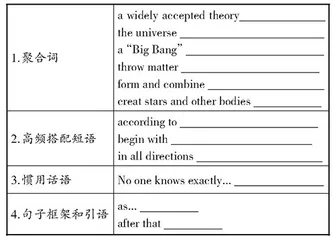基于语块理论的艺术生英语阅读教学探索
作者: 黎青

[摘 要]文章以语块理论为基础,结合人教版高中英语必修3 Unit 4 “Astronomy: the science of the stars”的阅读教学,探讨并反思在阅读教学的各环节中,如何利用语块理论对艺术生进行针对性的英语阅读教学,培养艺术生的语块意识和自主学习能力,促进艺术生阅读理解能力的提高。
[关键词]语块理论;艺术生;英语;阅读教学
[中图分类号] G633.41 [文献标识码] A [文章编号] 1674-6058(2022)01-0028-03
阅读教学是高中英语教学的重点。笔者一直以来都在探索和研究提高高中阶段艺术生英语阅读理解能力的方法和策略,发现艺术生面前最大的拦路虎就是英语词汇。为了帮助艺术生积累词汇、提高阅读理解能力,笔者认真学习和研究语块理论,并把语块教学融入英语阅读课堂教学,在教学实践中取得了明显的成效。
一、语块理论
Becker最早对语块进行研究,他认为,语言的记忆和存储、输出和使用并不是以单个的词为单位,而是以那些固定或半固定的、模式化了的板块结构为单位。20世纪90年代,Michael Lewis提出语块理论,他认为,语块在语言交际中出现频率较高,形式、结构、意义较为固定,运用语境较为确定,兼具词汇和语法功能。语块可根据其结构、功能、成分词数和出现频率来分类。本文采用Lewis(1997)的语块分类方法,把语块分为以下四种:1.聚合词,即由两个或两个以上的单词组合而成的固定词组,既不能拆开,也不能任意替换其中的单词,如a chain reaction、the earth’s atmosphere等。2.高频搭配短语,主要是那些出现频率很高的短语,如be able to、as well as等。3.惯用话语,即形式固定或半固定、兼有语用功能的单词组合,如“What’s the matter?”“I’d like to...”等。4.句子框架和引语。这类语块只用于书面语,是形式和功能固定或半固定的短语,而且发挥着组织篇章的作用,如“first..., next..., after that..., finally...”“it is obvious that...”等。
从上述语块分类可看出,语块是语言的半成品,集语义、语法、语境于一体,是理想的词汇记忆模式。因此,将语块教学融入英语阅读教学,对帮助艺术生提高阅读速度、加深语篇理解、把握语篇结构及文体特点等有显著的效果,是提高学生英语阅读能力的有效途径。
二、教学课例
本次课的内容出自人教版高中英语必修3 Unit 4“Astronomy: the science of the stars”。本单元的话题是天文学,热身部分介绍了太阳系八大行星,激发了学生对天文学的兴趣。阅读部分的课文标题是“How life began on the earth(地球生命起源)”,这是一篇科普性文章,术语多,句子结构复杂,学生读起来比较困难。以往对于本单元的教学,笔者只是简单地讲授词汇,没有让学生学习本单元的阅读课文。这样操作主要是基于以下原因:一是考虑到本单元的教学难度大,学生阅读起来有一定困难;二是有关天文学的话题在高考全国卷阅读理解题中很少出现。但是,笔者发现词汇教学脱离一定的文本和语境往往是生硬的、无趣的,也不能给学生留下深刻的印象。因此,笔者决定尝试利用语块进行本单元的阅读教学。
在授课前,笔者布置了预习课文、完成预习学案的任务。预习任务包括以下几项:1. 熟读本单元的单词和短语。2. 读懂文章大意以及各段的内容,并完成段落大意的配对练习。3. 画出课文中的语块并进行分类。为了让学生能够很好地在阅读时识别语块,笔者在预习学案中给出课文第一段中的语块作为示例,并要求学生翻译语块,这样也有助于学生理解第一段的内容。预习学案如下:
Task 1: Match the main idea with the paragraphs.
Para. 1 The formation of the earth.
Para. 2 The importance of water for life.
Para. 3 A widely accepted theory about
the formation of the universe.
Para. 4 The arrival of humans and their
impact on the earth.
Para. 5 The development of plants and
animals on the earth.
Task 2: Write down the meaning of the chunks in the first paragraph.
Task 3:Underline the chunks in para. 2—5.
【设计说明】课前预习学案一方面可以帮助学生了解文章的大意及各段落的内容,提高学生理解句子和归纳段落大意的能力,另一方面可以培养学生在课文中查找语块、识别语块的能力,加深学生对文章内容的理解。
在读前活动环节,笔者通过一系列提问引导学生通过关注课文标题及图片来获取文章大意, 同时拓展文章主旨大意的同义表达,帮助学生在语境中复习“the development of”“the origin of”“come into being”等已学过的语块,加深学生对文章标题和主旨大意的理解。此外,笔者引导学生思考文章的叙述顺序,让学生了解文章的文体特点。具体设计如下(画线处为让学生填写的内容):
What is the passage about according to the title and the pictures?
How do you understand the title? What do the pictures show us?
Title: How life began on the earth
Picture 1: a “Big Bang”
Picture 2:the evolution of life on the earth
Main idea:It’s about the development (/ origin) of life on the earth/how life on the earth came into being.
The passage is developed in time order.
【设计说明】通过对文章标题及图片的解读,让学生进一步理解文章主旨大意,了解文章的文体特点。同时让学生积累语块,丰富语言表达。
在读中活动环节,笔者检查学生预习任务完成情况,让学生分组罗列出各段落的语块,并通过让学生回答问题、绘制地球生命进程时间轴来检测学生对各自然段的理解。语块分享交流环节极大地调动了学生自主学习、合作学习的积极性,也促进了学生对文章各段落的理解。笔者设计的阅读任务如下:
Group 1: Read para. 2 and answer the questions.
1.What did the earth look like after the “Big Bang”?
2.What made the earth’s atmosphere?
Chunks in para. 2: a cloud of dust, be uncertain,between... and..., settle into, a solid globe, so... that..., become violent, it is not clear whether... or not, explode loudly, in time, the earth’s atmosphere, cool down, appear on one’s surface, what is more important is that...
Group 2: Read para. 3 and answer the questions.
1.Why was the earth different from other planets?
2.Why was water so important for the beginning of life?
Chunks in para. 3: on other planets, it is obvious that..., be fundamental to, the development of life, the continued presence of water, allow sth. to do, dissolve sth. into, a chain reaction, make it possible for sb. to do sth...
Group 3: Read para. 4—5 and finish the tasks.
1.Make a timeline of the development of life.
2.Why did the plants grow before the animals came?
3.What problem is caused by human beings?
The development of life:
(chunks: first..., next..., later..., after that..., finally... )
①small plants on surface of water→②early shellfish and all sorts of fish→③green plants on land→④land animals, insects(on land), amphibians(on land and in water)→⑤forests, reptiles(huge animal—dinosaurs)→⑥Mammals—clever animals (human beings)
Chunks in para. 4: the first extremely small plants, appear on the surface of the water, fill... with..., all sorts of, on land, be followed by, land animals, some... others..., be able to, as well as, for the first time, produce young, by doing sth., lay eggs, exist on the earth, the age of the dinosaurs, remain a mystery, the rise of mammals, be different from, all life forms, in the past, give birth to, produce milk...